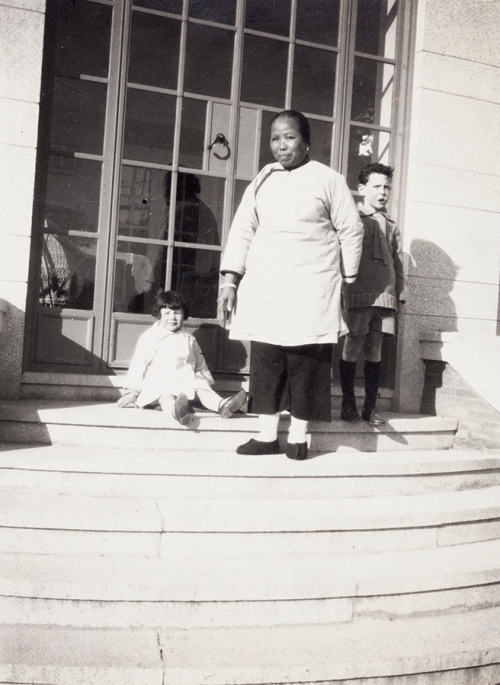A range of historians and public history practitioners have brought to light the stories of travelling Indian ayahs in Britain. [1] Much less is known about the Chinese amahs that travelled with employer families to Britain. The stories of the Chinese amahs and Indian ayahs who travelled to Australia (even after the passing of the infamous White Australia Policy in 1901) also remain largely unknown. Our project seeks to uncover those histories and to analyse Indian ayahs and Chinese amahs side-by-side.
Documenting the journeys of these workers is a challenging task that involves piecing together very different sorts of records, from shipping idents to official correspondence, from employers’ memoirs to photographs. Thus far we have uncovered some intriguing stories that suggest how Chinese amahs navigated national and imperial borders. In this blog I share some of my initial findings.
In June 1920, a British colonist by the name of F. W. S. Evans wrote to the Colonial Secretary of Hong Kong describing the challenges he had faced upon landing in England with a Chinese amah. Leung Ah Kum had been engaged to assist Evans’ wife in caring for their infant daughter. Despite having obtained the necessary passport for Leung, she was refused permission to land in Liverpool. Evans was required to obtain a new passport from the Chinese Legation before she was eventually let off the ship. The Governor of Hong Kong, Reginald Edward Stubbs, took the case seriously, forwarding the letter to Secretary of State for the Colonies, Viscount Alfred Milner. Stubbs urged Milner to liaise with the Home Office to avoid such problems in the future. He noted that ‘these servants are frequently taken home by their employers to assist in looking after children on the voyage and in all cases they return to the East on the expiry of their employers’ leave of absence.’ [2]
In emphasising the temporary nature of Chinese amahs’ presence in England, Stubbs was perhaps mindful of an earlier era when domestic servants who travelled from the colonies with employer families were at risk of becoming stranded in England. This situation was so common that a home for Indian ayahs was established in Hackney to provide accommodation and support for ayahs waiting to find a passage back to India.[3] Photographs of the home, such as Figure 1, indicate that at least one Chinese amah also resided there in 1904.

We do not yet know how many Chinese amahs resided in England or how long they stayed. Certainly, some of these women spent a considerable amount of time in the country. In his memoir of a childhood spent between Shanghai and England, Robert Basil Johnson recalled that his amah travelled with the family when they returned to England in 1935. After working for the Johnson family, she was engaged as an amah by another family in Essex in 1942 and seems not to have returned to China until after 1945. [4] The name of the amah was not recorded by the family but images of her were preserved within their photograph albums, including Figure 2.

As well as journeying to England, Chinese amahs travelled with employer families to Australia. Between 1940 and 1942, for example, hundreds of British women and children were evacuated to Australia from Hong Kong, Singapore and Malaya in the context of Japanese wartime expansionism. Some brought their Chinese amahs with them. The Chinese amahs that accompanied coloniser women and children to Australia did so on their own terms. Those travelling from Singapore, for example, reportedly used an ‘Amahs Union’ to advocate for the advance payment of a $200 (Straits) bonus prior to departure. [5]
Perhaps the most famous Chinese amah evacuated to Australia during the Second World War (and certainly the most photographed) was Lau Gau shown in Figure 3 and referred to as ‘Au Cheu’. She arrived in 1942 from the American Philippines with General Douglas Macarthur, his wife, Jean, and their young son, Arthur. Soon after his arrival General Macarthur was appointed Supreme Commander and led the allied campaign against the Japanese in the Pacific from his base in Australia. The press was fascinated with the family, documenting their outings and impressions of Australia and even interviewing Lau Gau. [6]

If the question of how long Indian and Chinese nursemaids might stay was of concern for the British government, it was even more pressing for Australian Commonwealth government officials. When war came to an end, around one hundred amahs who had travelled with evacuee families appealed to the Commonwealth government to be allowed to settle permanently in Australia. By 1948 it seems that all of the women had been forced out the country – victims of the ongoing White Australia Policy. [7]
Claire Lowrie 2021
[1] For foundational academic work see: Rozina Visram, 1986. Ayahs, Lascars and Princes: The story of Indians in Britain 1700-1947. Pluto Press. In terms of a public history initiative, and one that draws on domestic worker iconography, see the campaign for a Blue Plaque for the Hackney Ayahs Home and associated Instagram account: https://www.instagram.com/ayahshome/?hl=en
[2] Letter from R. E. Stubbs to A. Milner, 7 June, 1920. Hong Kong Public Records Office, Colonial Dispatches, CO129/461.
[3] For more on the Ayahs Home see Olivia Robinson, 2018. ‘Travelling Ayahs of the Nineteenth and Twentieth Centuries.’ History Workshop Journal 86: 44-66.
[4] ‘A Brief Survey of the Johnson Family Branch Descended from Charles Johnson (1811-1881) of Park Hill, Little Bolton’. The George Johnson Collection, Historical Photographs of China, Special Collections, University of Bristol.
[5] ‘Another Ramp’, Straits Times, 11 August 1940
[6] Mrs. MacArthur arrived in 1937 wedding coat, Australian Women’s Weekly, 4 April 1942
[7] ‘50 Chinese wedded to Australians’, Straits Times, 23 April 1948. For more information about the lives of Chinese women in Australia see Kate Bagnall and Julia T. Martínez (eds), Locating Chinese Women: Historical Mobility between China and Australia. Hong Kong University Press. 2021.

One thought on “Chinese amahs in Britain and Australia”